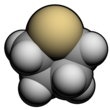
Summary
Tetrahydrothiophene is an organosulfur compound with the formula (CH2)4S. The molecule consists of a five-membered saturated ring with four methylene groups and a sulfur atom. It is the saturated analog of thiophene. It is a volatile, colorless liquid with an intensely unpleasant odor. It is also known as thiophane, thiolane, or THT.
| |||
| Names | |||
|---|---|---|---|
| Preferred IUPAC name
Thiolane | |||
| Other names
Tetrahydrothiophene,
thiophane, tetramethylene sulfide | |||
| Identifiers | |||
| |||
3D model (JSmol)
|
| ||
| Abbreviations | THT | ||
| 102392 | |||
| ChEBI |
| ||
| ChEMBL |
| ||
| ChemSpider |
| ||
| ECHA InfoCard | 100.003.391 | ||
| EC Number |
| ||
PubChem CID
|
| ||
| RTECS number |
| ||
| UNII |
| ||
| UN number | 2412 | ||
CompTox Dashboard (EPA)
|
| ||
| |||
| |||
| Properties | |||
| C4H8S | |||
| Molar mass | 88.17 g·mol−1 | ||
| Appearance | colorless liquid | ||
| Density | 0.997 g/mL[1] | ||
| Melting point | −96 °C (−141 °F; 177 K) | ||
| Boiling point | 119 °C (246 °F; 392 K) | ||
| Hazards | |||
| Occupational safety and health (OHS/OSH): | |||
Main hazards
|
Stench, flammable, irritant | ||
| GHS labelling: | |||
 
| |||
| Danger | |||
| H225, H302, H312, H315, H319, H332, H412 | |||
| P210, P233, P240, P241, P242, P243, P261, P264, P270, P271, P273, P280, P301+P312, P302+P352, P303+P361+P353, P304+P312, P304+P340, P305+P351+P338, P312, P321, P322, P330, P332+P313, P337+P313, P362, P363, P370+P378, P403+P235, P501 | |||
| Flash point | 12 °C (54 °F; 285 K) | ||
| 200 °C (392 °F; 473 K) | |||
| Safety data sheet (SDS) | Oakwood | ||
| Related compounds | |||
Related compounds
|
Tetrahydrofuran, Thiophene, Selenolane, Thiazolidine, Dithiolane, Thiane | ||
Except where otherwise noted, data are given for materials in their standard state (at 25 °C [77 °F], 100 kPa).
Infobox references
| |||
Synthesis and reactions edit
Tetrahydrothiophene is prepared by the reaction of tetrahydrofuran with hydrogen sulfide. This vapor-phase reaction is catalyzed by alumina and other heterogenous acid catalysts.[2][3]
This compound is a ligand in coordination chemistry, an example being the complex chloro(tetrahydrothiophene)gold(I).[4]
Oxidation of THT gives the sulfone sulfolane, which is of interest as a polar, odorless solvent:
- C4H8S + 2 O → C4H8SO2
Sulfolane is, however, more conventionally prepared from butadiene.
Natural occurrence edit
Both unsubstituted and substituted tetrahydrothiophenes are reported to occur in nature. For example, tetrahydrothiophene occurs as a volatile from Eruca sativa Mill. (salad rocket)[5] while monocyclic substituted tetrahydrothiophenes have been isolated from Allium fistulosum 'Kujou',[6] Allium sativum (garlic),[7] Allium cepa (onion),[8] Allium schoenoprasum (chives),[9] and Salacia prinoides.[10] Albomycins are a group of tetrahydrothiophene-ring containing antibiotics from streptomyces while biotin and neothiobinupharidine (and other nuphar alkaloids [11]), are examples of bicyclic and polycyclic tetrahydrothiophene-ring containing natural products, respectively.
Applications edit
Because of its smell, tetrahydrothiophene has been used as an odorant in LPG,[3] albeit no longer in North America. It is also used as an odorant for natural gas, usually in mixtures containing tert-butylthiol.
Tetrahydrothiophene is a Lewis base classified as a soft base and its donor properties are discussed in the ECW model.
See also edit
References edit
- ^ Armarego WF, Chai CL (2003). "Purification of Organic Chemicals". Purification of Laboratory Chemicals. p. 361. doi:10.1016/B978-075067571-0/50008-9. ISBN 9780750675710.
- ^ Loev, B; Massengale, JT U. S. Patent 2,899,444, "Synthesis of Tetrahydrothiophene", 8/11/1959
- ^ a b Jonathan Swanston (2006). "Thiophene". Ullmann's Encyclopedia of Industrial Chemistry. Weinheim: Wiley-VCH. doi:10.1002/14356007.a26_793.pub2. ISBN 978-3527306732.
- ^ Uson R, Laguna A, Laguna M, Briggs DA, Murray HH, Fackler JP (2007). "(Tetrahydrothiophene)Gold(I) or Gold(III) Complexes". Inorganic Syntheses. Vol. 26. pp. 85–91. doi:10.1002/9780470132579.ch17. ISBN 9780470132579. ISSN 1934-4716.
- ^ Aissani N, et al. (2006). "Nematicidal Activity of the Volatilome of Eruca sativa on Meloidogyne incognita". Journal of Agricultural and Food Chemistry. 63 (27): 6120–6125. doi:10.1021/acs.jafc.5b02425. PMID 26082278.
- ^ Fukaya M, et al. (2018). "Rare Sulfur-Containing Compounds, Kujounins A1 and A2 and Allium Sulfoxide A1, from Allium fistulosum 'Kujou'". Organic Letters. 20 (1): 28–31. doi:10.1021/acs.orglett.7b03234. PMID 29227665.
- ^ Block E, et al. (2018). "Ajothiolanes: 3,4-Dimethylthiolane Natural Products from Garlic (Allium sativum)". Journal of Agricultural and Food Chemistry. 66 (39): 10193–10204. doi:10.1021/acs.jafc.8b03638. OSTI 1490686. PMID 30196701. S2CID 52178061.
- ^ Aoyagi M, et al. (2011). "Structure and Bioactivity of Thiosulfinates Resulting from Suppression of Lachrymatory Factor Synthase in Onion". Journal of Agricultural and Food Chemistry. 59 (20): 10893–10900. doi:10.1021/jf202446q. PMID 21905712.
- ^ Fukaya M, et al. (2019). "Cyclic Sulfur Metabolites from Allium schoenoprasum var. foliosum". Phytochemistry Letters. 29: 125–128. Bibcode:2019PChL...29..125F. doi:10.1016/j.phytol.2018.11.018. S2CID 104387714.
- ^ Tanabe G, et al. (2008). "Synthesis and Elucidation of Absolute Stereochemistry of Salaprinol, another Thiosugar Sulfonium Sulfate from the Ayurvedic Traditional Medicine Salacia prinoides". Tetrahedron. 64 (43): 10080–10086. doi:10.1016/j.tet.2008.08.010.
- ^ Korotkov A, et al. (2015). "Total Syntheses and Biological Evaluation of Both Enantiomers of Several Hydroxylated Dimeric Nuphar Alkaloids". Angewandte Chemie International Edition. 54 (36): 10604–10607. doi:10.1002/anie.201503934. PMC 4691328. PMID 26205039.




